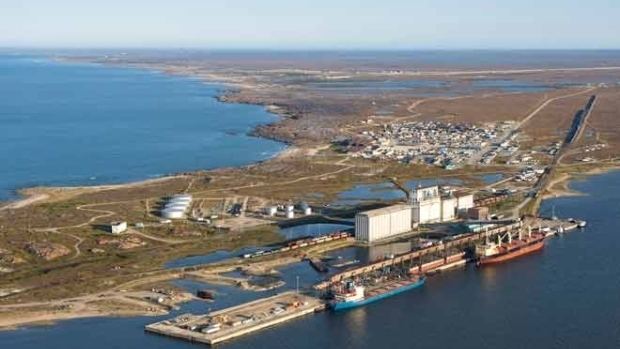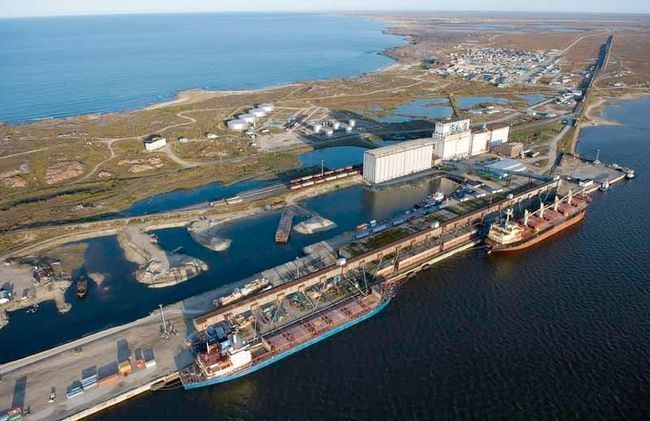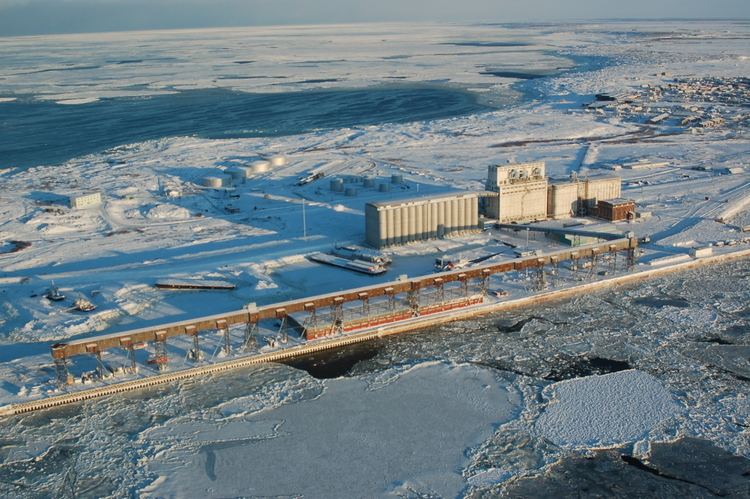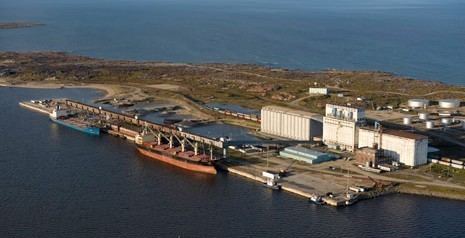 | ||
The port of churchill opens grain shipping season
The Port of Churchill in Churchill, Manitoba, Canada is a port on Hudson Bay, part of the Arctic Ocean.
Contents
- The port of churchill opens grain shipping season
- Port of churchill
- History
- Port operations
- Alternatives to grain
- References

The port was originally owned by the Government of Canada but was sold in 1997 to the American company OmniTRAX to run privately. In December 2015, OmniTRAX announced it was negotiating a sale of the port, and the associated Hudson Bay Railway, to a group of First Nations based in northern Manitoba. No sale had been finalized by July 2016, and OmniTRAX shut down the port and the railroad freight operations in August 2016.

As of 2008, the port had four deep-sea berths capable of handling Panamax-size vessels for the loading and unloading of grain, bulk commodities, general cargo, and tanker vessels. The port is connected to the Hudson Bay Railway, a subsidiary of OmniTRAX. Further connections are made with the Canadian National Railway system. It was the only port of its size and scope in Canada that did not connect directly to the country's road system; all goods shipped overland to and from the port have to go by rail.

Port of churchill
History

The port was built in the late 1920s, and first opened for grain shipments in 1931, following a six-year project to build the railroad to connect the town and port to other points in Canada.

The port—and all freight railroad service to the port—was shut down in August 2016 following the Government of Canada's ending of the Wheat Board monopoly, which subsequently allowed Canadian farmers to sell grain to all market participants, and shippers were free to ship via lower-cost non-Arctic ports and transport routes.
Port operations

The port is iced in for much of the year and is accessible only between late July and early November. For example, in 2010 the shipping season was July 28 to Nov. 2. Shallow waters also restrict its development as an ocean port. Despite these restrictions the port remains useful for shipping grain and other bulk cargos because shipping by rail costs several times as much, per ton, as shipping by sea.
The port is a compulsory pilotage area. Pilotage is provided by the Great Lakes Pilotage Authority, a Crown corporation of the Government of Canada which includes responsibility for pilotage on the Hudson Bay coast of the provinces of Ontario and Manitoba. Pilotage charges between July 20 and October 31 follow a published schedule; outside these dates charges are based on cost recovery.
During 1931–2016, the port typically was used for outgoing shipments of grain, usually from the Canadian Wheat Board.
Since 2007 port activity diversified somewhat and increased in line with growth in Arctic mining operations in Nunavut and an expansion in supply ship reloading. In September 2007 the port handled its first domestic export trade, shipping 12,500 tonnes of wheat to Halifax aboard the Arctic supply ship Kathryn Spirit. On October 18, 2007 the port received its first import trade in seven years and the first ever from Russia, a shipment of fertilizer purchased by Farmers of North America. The shipment is supposed to be the beginning of an Arctic Bridge that would link Churchill with the Russian port of Murmansk.
The port was almost entirely reliant on grain from the Canadian Wheat Board (CWB) for its viability. Wheat accounted for 90 per cent of all traffic through the port. According to a November 6, 2008 press release, the CWB shipped 424,000 tons of western Canadian wheat through the port of Churchill during the 2008 shipping season. The first wheat left port on August 8, and the last of 15 freighters left on October 20. Exporting Prairie wheat through Churchill saves Canadian farmers money on transportation in terms of rail-freight costs and avoiding Saint Lawrence Seaway charges, but the operating profits to the private company operating the port were highly dependent on the monopoly rates and rules implemented by the CWB. The CWB incentivized shipments via the port through the use of its Churchill Storage Program which paid farmers to retain grain on-farm for later movement through the port. Because the Churchill shipping season begins before the new wheat crop is harvested each summer, the Storage Program helped ensure adequate volumes of grain are available for export by bringing in grain saved from the year before.
The port of Churchill exported 710,000 tonnes (700,000 long tons; 780,000 short tons) of grain in 1977, 621,000 tonnes in 2007, and 529,000 tonnes in 2009. Shipments continued to decline, falling to 432,434 tonnes (425,604 long tons; 476,677 short tons) in 2012 and plummeting to 186,000 tonnes (183,000 long tons; 205,000 short tons) in 2015. Port operations ceased in August 2016.
Alternatives to grain
The government of Manitoba proposed in 2010 that the Port of Churchill could serve as the North American terminus of an Arctic Bridge shipping service to Murmansk in Northern Russia. Containers from inland China and central Asia could potentially be transported to Murmansk by Russian railways, shipped to Churchill then transported south by rail to major destinations in North America avoiding existing transport bottlenecks.
In 2010, investments to upgrade the port to, "facilitating export options and the flow of two-way trade with other Northern ports." were made, as described in the Statement on Canada's Arctic Foreign Policy: Exercising : Sovereignty and Promoting Canada's Northern Strategy Abroad which is launched on August 20 2010.
